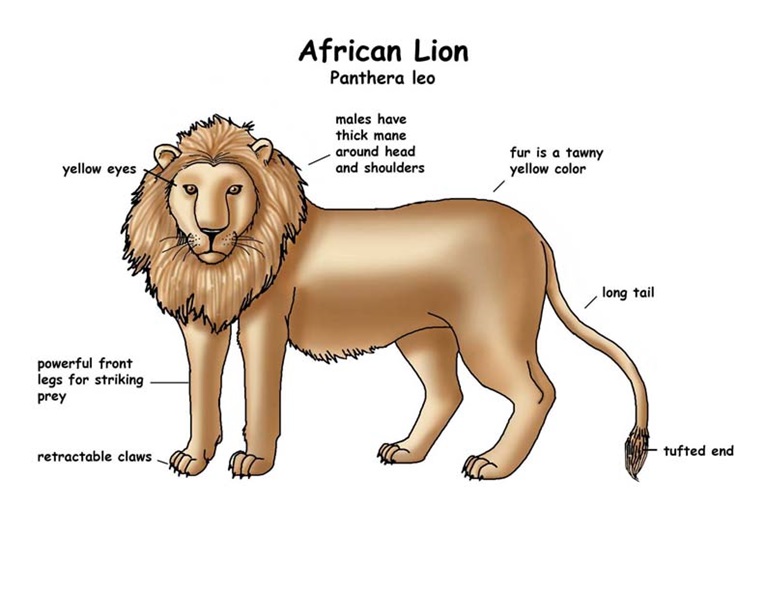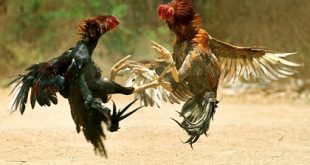The lion, often referred to as the “King of the Jungle,” is a fascinating creature known for its strength, agility, and majestic appearance. Each part of its body is intricately designed to perform specific functions that allow it to thrive as a dominant predator in its natural habitat. In this article, we will explore the various body parts of a lion and their respective functions, offering insights into how these features contribute to its survival and prowess.
A Body Part of A Lion

1. The Mane
The mane is a hallmark feature of male lions, consisting of a thick growth of hair around their neck and shoulders. This feature serves several important purposes:
- Protection: During fights with rival males, the mane acts as a shield, protecting the lion’s neck and throat from bites and scratches.
- Attractiveness: A thick, dark mane is often seen as a sign of strength and health, making male lions with impressive manes more attractive to females during mating.
- Intimidation: The mane makes a male lion appear larger and more formidable, helping to ward off potential rivals.
2. The Eyes
Lions have large, forward-facing eyes that are adapted for excellent vision, particularly in low-light conditions. This is vital for a nocturnal predator. Key features and functions of a lion’s eyes include:
- Night Vision: Lions have a high concentration of rod cells in their retinas, allowing them to see well in the dark.
- Depth Perception: Their forward-facing eyes provide binocular vision, essential for judging distances when stalking prey.
- Spotting Movement: Lions are highly sensitive to movement, which helps them detect prey even at a distance.
3. The Ears
A lion’s ears are highly mobile and play a critical role in communication and hunting. Their functions include:
- Hearing: Lions have acute hearing, capable of detecting sounds from several kilometers away, which is crucial for locating prey or responding to calls from pride members.
- Expression: Lions use ear movements to express emotions. Flattened ears, for instance, may indicate aggression or fear.
- Focus: The ability to swivel their ears allows lions to pinpoint the direction of sounds with precision.
4. The Teeth and Jaws
The teeth and jaws of a lion are among its most powerful weapons. They are specifically adapted for capturing and consuming prey:
- Canines: The long, sharp canine teeth are used to grip and kill prey, often by delivering a fatal bite to the neck or throat.
- Carnassials: These specialized teeth act like scissors, slicing through flesh and breaking bones.
- Strong Jaws: A lion’s jaw strength enables it to crush bones and tear through tough hides with ease.
5. The Claws
Lions possess retractable claws that are essential for hunting and defense. These claws serve multiple purposes:
- Hunting: Sharp and curved claws help lions grip and hold onto prey during a chase or attack.
- Climbing: Though not as skilled as leopards, lions can use their claws to climb trees, especially young lions.
- Defense: In fights, a lion’s claws are formidable weapons that can cause serious injury to opponents.
6. The Tail
A lion’s tail is more than just a decorative appendage. It serves several functional purposes:
- Balance: The tail helps lions maintain balance, especially when making sharp turns during a chase.
- Communication: Lions use their tails to signal intentions or emotions to other pride members, such as flicking their tails to indicate irritation or alertness.
- Guidance: Cubs often follow the movement of their mother’s tail as a visual cue.
7. The Paws
A lion’s paws are uniquely adapted for stealth and power. Their functions include:
- Stealth: The soft pads on the bottom of their paws allow lions to move silently when stalking prey.
- Grip: Their paws provide a strong grip on the ground, which is crucial during a high-speed chase.
- Impact: The sheer size and strength of their paws make them powerful tools for striking prey or opponents.
8. The Muscles
Lions are muscular animals, with a build that emphasizes power and speed. Their muscles are designed for:
- Strength: Strong forelimb and shoulder muscles enable lions to wrestle prey to the ground.
- Speed: While not long-distance runners, lions can sprint at speeds of up to 50 miles per hour (80 km/h) over short distances.
- Endurance: Their muscular build supports short bursts of intense activity, such as a chase or fight.
9. The Fur and Skin
A lion’s fur and skin offer protection and camouflage in its environment:
- Camouflage: The tawny color of their fur blends seamlessly with the savanna grasslands, making them less visible to prey.
- Temperature Regulation: Their fur provides insulation against both the heat of the day and the chill of the night.
- Protection: The skin and fur act as a barrier against minor injuries and insect bites.
10. The Heart and Lungs
The cardiovascular and respiratory systems of a lion are optimized for bursts of activity:
- Heart: A lion’s heart is large and powerful, enabling it to pump oxygen-rich blood to its muscles during intense activity.
- Lungs: Their lungs support rapid breathing during a chase, ensuring adequate oxygen intake to sustain their exertion.
11. The Stomach and Digestive System
Lions have a digestive system tailored to their carnivorous diet:
- Large Stomach: Lions can consume up to 15% of their body weight in a single meal, and their large stomachs accommodate this.
- Efficient Digestion: Their digestive system breaks down raw meat and bones effectively, extracting maximum nutrients.
- Energy Storage: Excess energy is stored as fat, allowing lions to endure periods of food scarcity.
12. The Whiskers
Lions have long, sensitive whiskers that are essential sensory tools:
- Touch Sensation: Whiskers help lions detect their surroundings, particularly in the dark.
- Communication: The position and movement of whiskers can indicate a lion’s mood or intentions.
- Prey Handling: Whiskers near the mouth help lions sense and manipulate their catch.
Conclusion
Every body part of a lion plays a vital role in its survival, from its keen eyes and powerful jaws to its muscular build and sensitive whiskers. These adaptations make lions efficient hunters and formidable predators, ensuring their dominance in the ecosystems they inhabit. Understanding these features not only highlights the complexity of their biology but also deepens our appreciation for these magnificent animals. Through conservation efforts, we can help protect lions and their habitats, ensuring they continue to reign as the “King of the Jungle” for generations to come.


